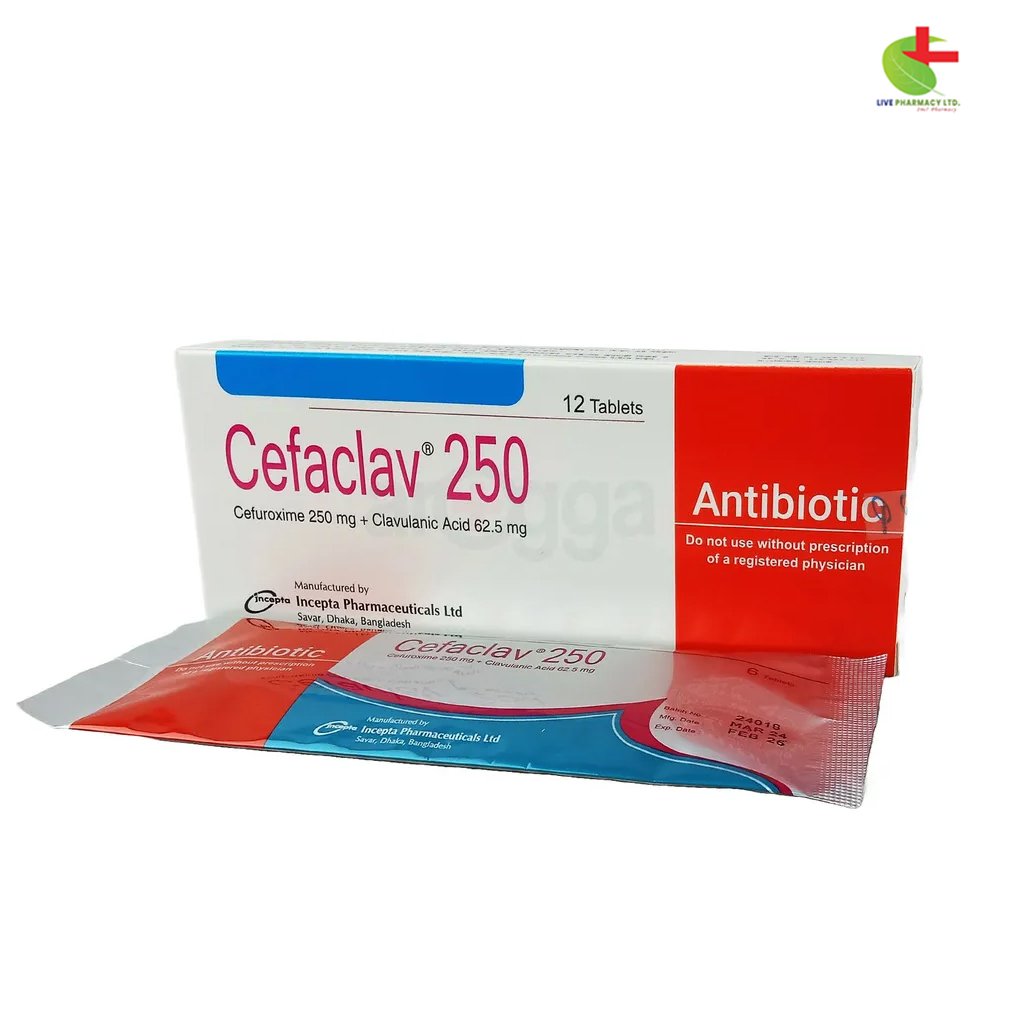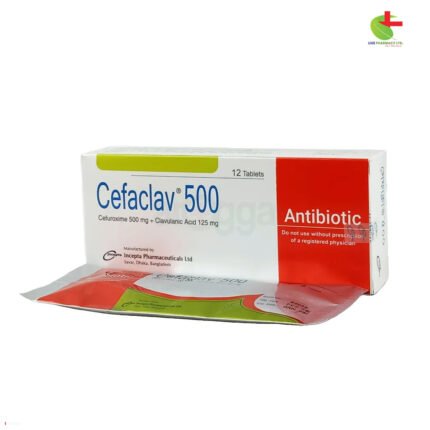Cefaclav 250
210.00৳ Strip
- Cefaclav is a potent antibiotic combining Cefuroxime and Clavulanic Acid, effective against a wide range of bacterial infections.
- Treats conditions such as pharyngitis, acute otitis media, pneumonia, and urinary tract infections caused by sensitive bacteria, including resistant strains.
- Its dual-action mechanism disrupts bacterial cell wall synthesis while protecting against beta-lactamase degradation.
- Suitable for both adults and children, it offers flexible dosing options for effective treatment.
 Brand
Brand
|
Incepta Pharmaceuticals Ltd |
|---|---|
 Generics
Generics
|
Cefuroxime Axetil + Clavulanic Acid |
 Type
Type
|
Tablet |
Indications
Cefaclav is prescribed for treating infections linked to bacteria that are susceptible to its effects, including:
- Pharyngitis/Tonsillitis: Effective against Streptococcus pyogenes.
- Acute Bacterial Otitis Media: Targets Streptococcus pneumoniae, Haemophilus influenzae, Moraxella catarrhalis (including beta-lactamase producing strains), and Streptococcus pyogenes.
- Acute Bacterial Maxillary Sinusitis: Aids in infections caused by Streptococcus pneumoniae and non-beta-lactamase producing Haemophilus influenzae.
- Lower Respiratory Tract Infections: Includes pneumonia caused by a variety of bacteria such as Streptococcus pneumoniae, Haemophilus influenzae (both beta-lactamase producers and non-producers), Klebsiella spp., Staphylococcus aureus (both penicillinase and non-penicillinase producing strains), Streptococcus pyogenes, and E. coli.
- Acute Bacterial Exacerbation of Chronic Bronchitis: Treats secondary bacterial infections stemming from acute bronchitis, with effective coverage for Streptococcus pneumoniae, non-beta-lactamase Haemophilus influenzae, and Haemophilus parainfluenzae.
- Uncomplicated Skin and Skin Structure Infections: Effective against Staphylococcus aureus (including beta-lactamase producing strains) and Streptococcus pyogenes.
- Uncomplicated Urinary Tract Infections: Targets E. coli and Klebsiella pneumoniae.
- Bone and Joint Infections: Specifically addresses infections caused by Staphylococcus aureus (both penicillinase and non-penicillinase producers).
- Uncomplicated Gonorrhea: Covers both penicillinase-producing and non-producing strains of Neisseria gonorrhoeae.
- Early Lyme Disease (Erythema Migrans): Treats infections caused by Borrelia burgdorferi.
- Septicemia: Effective against Staphylococcus aureus, Streptococcus pneumoniae, E. coli, Haemophilus influenzae (including ampicillin-resistant strains), and Klebsiella spp..
- Meningitis: Targets Streptococcus pneumoniae, Haemophilus influenzae (including ampicillin-resistant strains), Neisseria meningitidis, and Staphylococcus aureus (both penicillinase and non-penicillinase producers).
- Switch Therapy: Facilitates the transition from injectable to oral formulations.
Pharmacology
Cefuroxime is a second-generation cephalosporin antibiotic with bactericidal properties, effective against a broad spectrum of Gram-positive and Gram-negative bacteria, including many that produce beta-lactamase. It works by disrupting bacterial cell wall synthesis through interference with the transpeptidation process.
Clavulanic acid, a natural beta-lactamase inhibitor derived from Streptomyces clavuligerus, mimics beta-lactam antibiotics, binding irreversibly to beta-lactamase enzymes and rendering them inactive. This mechanism protects Cefuroxime from degradation by these enzymes, allowing effective treatment of infections caused by beta-lactam resistant bacteria.
Dosage & Administration
For Adolescents and Adults (13 years and older):
- Pharyngitis/Tonsillitis: 250 mg twice daily for 5-10 days.
- Acute Bacterial Maxillary Sinusitis: 250 mg twice daily for 10 days.
- Acute Bacterial Exacerbation of Chronic Bronchitis: 250-500 mg twice daily for 10 days.
- Secondary Bacterial Infections of Acute Bronchitis: 250-500 mg twice daily for 5-10 days.
- Uncomplicated Skin and Skin Structure Infections: 250-500 mg twice daily for 10 days.
- Uncomplicated Urinary Tract Infections: 250 mg twice daily for 7-10 days.
- Uncomplicated Gonorrhea: 1000 mg as a single dose.
- Community-Acquired Pneumonia: 250-500 mg twice daily for 5-10 days.
- MDR Typhoid Fever: 500 mg twice daily for 10-14 days.
- Early Lyme Disease: 500 mg twice daily for 20 days.
For Pediatric Patients (3 months to 12 years):
- Pharyngitis/Tonsillitis: 20 mg/kg/day, divided into two doses for 5-10 days.
- Acute Otitis Media: 30 mg/kg/day, divided into two doses for 10 days.
- Acute Bacterial Maxillary Sinusitis: 30 mg/kg/day, divided into two doses for 10 days.
- Impetigo: 30 mg/kg/day, divided into two doses for 10 days.
Cefuroxime-Clavulanic Acid tablets can be taken regardless of food intake.
Interactions
The co-administration of probenecid with Cefuroxime-Clavulanic Acid can increase serum concentration levels by 50%. Additionally, medications that reduce gastric acidity may lower the bioavailability of Cefuroxime, potentially diminishing its effectiveness.
Contraindications
Cefuroxime-Clavulanic Acid should not be used in patients with a known allergy to cephalosporins or those with a history of pseudomembranous colitis.
Side Effects
Cefuroxime-Clavulanic Acid is generally well tolerated. However, potential side effects may include nausea, vomiting, diarrhea, and abdominal discomfort. Prolonged use can lead to the overgrowth of nonsusceptible microorganisms. Rarely, serious side effects such as renal dysfunction, anaphylaxis, angioedema, rash, and serum sickness-like reactions may occur.
Pregnancy & Lactation
While the use of antibiotics in the first trimester should be minimized, Cefuroxime-Clavulanic Acid is considered safe in later stages of pregnancy for treating urinary and other infections. It is excreted in breast milk in small amounts, so the potential for sensitizing the infant should be taken into account.
Precautions & Warnings
Cefuroxime should be used cautiously in patients on potent diuretics or those with a history of colitis.
Therapeutic Class
Second Generation Cephalosporins
Storage Conditions
Store in a cool, dry environment (below 30°C), shielded from light and moisture. Keep out of reach of children.













Reviews
There are no reviews yet.